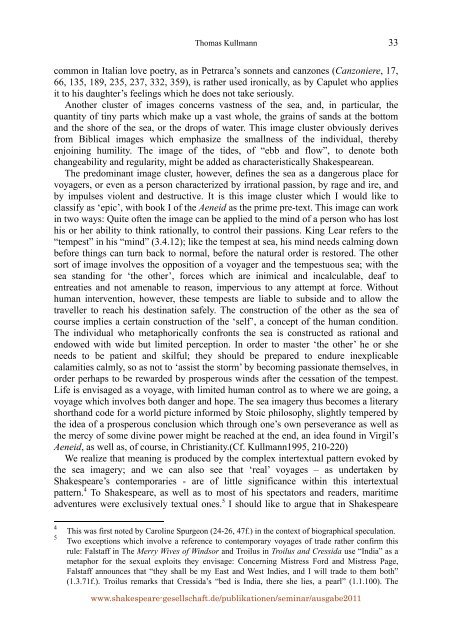Shakespeare Seminar - Shakespeare-Gesellschaft
Shakespeare Seminar - Shakespeare-Gesellschaft
Shakespeare Seminar - Shakespeare-Gesellschaft
Create successful ePaper yourself
Turn your PDF publications into a flip-book with our unique Google optimized e-Paper software.
Thomas Kullmann<br />
33<br />
common in Italian love poetry, as in Petrarca’s sonnets and canzones (Canzoniere, 17,<br />
66, 135, 189, 235, 237, 332, 359), is rather used ironically, as by Capulet who applies<br />
it to his daughter’s feelings which he does not take seriously.<br />
Another cluster of images concerns vastness of the sea, and, in particular, the<br />
quantity of tiny parts which make up a vast whole, the grains of sands at the bottom<br />
and the shore of the sea, or the drops of water. This image cluster obviously derives<br />
from Biblical images which emphasize the smallness of the individual, thereby<br />
enjoining humility. The image of the tides, of “ebb and flow”, to denote both<br />
changeability and regularity, might be added as characteristically <strong>Shakespeare</strong>an.<br />
The predominant image cluster, however, defines the sea as a dangerous place for<br />
voyagers, or even as a person characterized by irrational passion, by rage and ire, and<br />
by impulses violent and destructive. It is this image cluster which I would like to<br />
classify as ‘epic’, with book I of the Aeneid as the prime pre-text. This image can work<br />
in two ways: Quite often the image can be applied to the mind of a person who has lost<br />
his or her ability to think rationally, to control their passions. King Lear refers to the<br />
“tempest” in his “mind” (3.4.12); like the tempest at sea, his mind needs calming down<br />
before things can turn back to normal, before the natural order is restored. The other<br />
sort of image involves the opposition of a voyager and the tempestuous sea; with the<br />
sea standing for ‘the other’, forces which are inimical and incalculable, deaf to<br />
entreaties and not amenable to reason, impervious to any attempt at force. Without<br />
human intervention, however, these tempests are liable to subside and to allow the<br />
traveller to reach his destination safely. The construction of the other as the sea of<br />
course implies a certain construction of the ‘self’, a concept of the human condition.<br />
The individual who metaphorically confronts the sea is constructed as rational and<br />
endowed with wide but limited perception. In order to master ‘the other’ he or she<br />
needs to be patient and skilful; they should be prepared to endure inexplicable<br />
calamities calmly, so as not to ‘assist the storm’ by becoming passionate themselves, in<br />
order perhaps to be rewarded by prosperous winds after the cessation of the tempest.<br />
Life is envisaged as a voyage, with limited human control as to where we are going, a<br />
voyage which involves both danger and hope. The sea imagery thus becomes a literary<br />
shorthand code for a world picture informed by Stoic philosophy, slightly tempered by<br />
the idea of a prosperous conclusion which through one’s own perseverance as well as<br />
the mercy of some divine power might be reached at the end, an idea found in Virgil’s<br />
Aeneid, as well as, of course, in Christianity.(Cf. Kullmann1995, 210-220)<br />
We realize that meaning is produced by the complex intertextual pattern evoked by<br />
the sea imagery; and we can also see that ‘real’ voyages – as undertaken by<br />
<strong>Shakespeare</strong>’s contemporaries - are of little significance within this intertextual<br />
pattern. 4 To <strong>Shakespeare</strong>, as well as to most of his spectators and readers, maritime<br />
adventures were exclusively textual ones. 5 I should like to argue that in <strong>Shakespeare</strong><br />
4<br />
5<br />
This was first noted by Caroline Spurgeon (24-26, 47f.) in the context of biographical speculation.<br />
Two exceptions which involve a reference to contemporary voyages of trade rather confirm this<br />
rule: Falstaff in The Merry Wives of Windsor and Troilus in Troilus and Cressida use “India” as a<br />
metaphor for the sexual exploits they envisage: Concerning Mistress Ford and Mistress Page,<br />
Falstaff announces that “they shall be my East and West Indies, and I will trade to them both”<br />
(1.3.71f.). Troilus remarks that Cressida’s “bed is India, there she lies, a pearl” (1.1.100). The<br />
www.shakespeare-gesellschaft.de/publikationen/seminar/ausgabe2011





